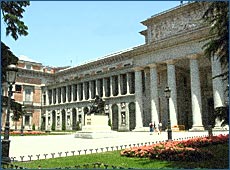|
|
|
|
 |
|
|
| » |
Barcelona's Sagrada Familia |
» |
Feria de Abril, Seville |
| » |
Prado Museum, Madrid |
» |
Picos de Europa |
| » |
Alhambra Palace – Granada |
» |
Balearic Islands |
| » |
Guggenheim Museum Bilbao |
» |
Cordoba and the Mezquita |
| » |
La Tomatina Festival, Buñol |
» |
Toledo |
| |
|
|
 |
| |
| The Museo del Prado (Prado Museum) is Madrid's one of the most popular tourist attraction, and one of the oldest and greatest collections of art in the world. Built as a natural science museum in 1775, the Prado opened to the public in 1819, and houses the finest works collected by Spanish royalty - for the most part avid, discerning, and wealthy buyers - as well as Spanish paintings gathered from other sources over the past two centuries. There are 7000 paintings in all, of which around 1500 are on permanent display. A controversial plan to modernize and extend the museum will enable the Prado to double the number of works currently on show. Local residents are opposing the proposed plan, designed by Spain's leading architect Rafael Moneo, to construct a new glass-fronted building to house the museum's offices in the cloisters of the church of San Jerónimo el Real. |
| |
| The Prado Museum’s highlights are its Flemish collection - including almost all of Bosch's best work - and of course its incomparable display of Spanish art, in particular that of Velázquez, Goya (including the Majas and the Black Paintings), and El Greco. There's also a huge section of Italian painters collected by Carlos V and Felipe II, both great patrons of the Renaissance, and an excellent collection of seventeenth-century Flemish and Dutch pictures gathered by Felipe IV. The Prado Museum in Madrid has also hosted an increasing number of temporary displays in recent years. Even in a full day you couldn't hope to do justice to everything here, and it's perhaps best to make a couple of more focused visits. If you are tempted to take advantage of the long opening hours, however, there's a decent cafeteria and restaurant in the basement. |
| |
|
|
|



